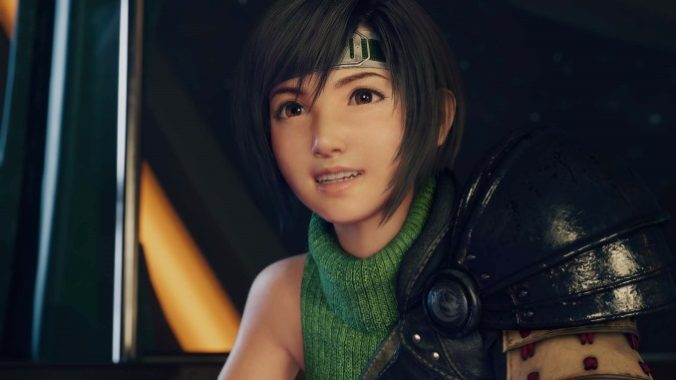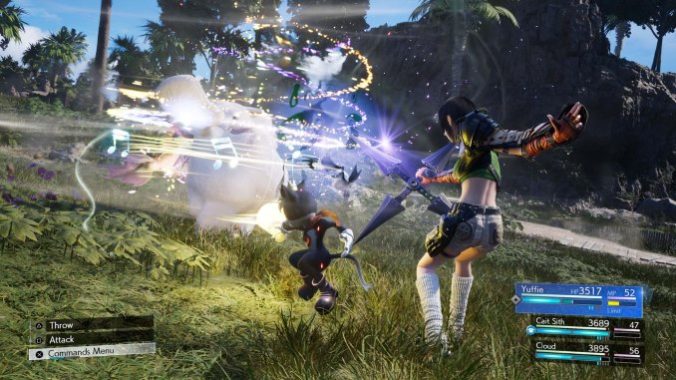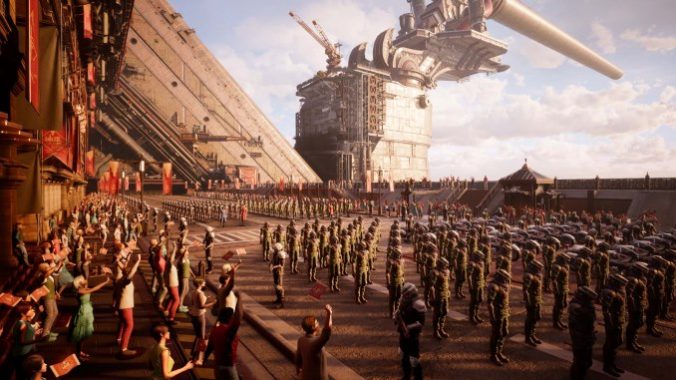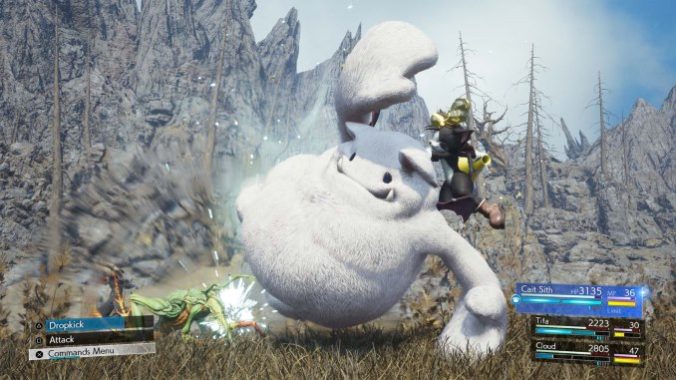Final Fantasy VII Rebirth Continues the Reinterpretation of One of Gaming’s Best Legends
Games Features Final Fantasy VII Rebirth
When Final Fantasy VII Remake released in 2020, nobody was entirely sure what we were getting. Without spoiling too much, because so much of that incredible game begs to be seen and heard firsthand, it reinterpreted and outright rewrote major parts of the original game, acting simultaneously as a meta commentary, remake, and continuation of the franchise built around Final Fantasy VII. It’s a bit heady but digestible, and a game clearly trying to work through the legacy of one of the greatest legends in gaming’s relatively short history. In the years since, there has been nonstop theorizing about what kind of game Final Fantasy VII Rebirth, the second part in a planned trilogy, would look like after the first took such creative liberties and surprising left turns instead of simply playing the hits. A few months ago, we got our answer. Final Fantasy VII Rebirth promises a sprawl to fit the age, with huge open zones and a zest for adventure in tune with the original’s open-ended second act, a fact that a recent preview of the game’s opening hours doubled down on. But for those aware of Final Fantasy VII‘s history, Rebirth, much more than Remake, also feels like a chance to refine and clarify, rather than flip the script entirely.
If you’re familiar with the sequence of events following Cloud and friends’ escape from Midgar, then you know the general trajectory of Rebirth‘s opening hours. If you aren’t, allow me to explain. The team settles in at an inn just outside Midgar in the quiet town of Kalm, where Cloud finally loosens his lips about his time with Sephiroth in SOLDIER, a private army for the Shinra Electric Power Company. This tale consists of one of Final Fantasy VII‘s pivotal moments, the Nibelheim flashback, where we follow a younger Cloud and Sephiroth on a joint team to Cloud’s childhood home. The pieces of this section come together in much the same way they always have, save for Rebirth‘s obvious graphical and performance upgrades, as well as the notable addition of Sephiroth’s playability. He is, for what it’s worth, exactly as powerful as he appeared to be when he joins your party in Final Fantasy VII in the same segment.
What intrigued me most about Rebirth’s opening was the Cloud of it all. In the aforementioned flashback, he comes across like an entirely different person. He’s youthful, boyish, and cocky. He’s overeager and desperately wants to prove himself to anyone willing to witness his feats. He finishes a conversation by squatting in front of another person. His interplay and banter with Sephiroth is something to behold, honestly. Something about his character—and the distinctions between his past and present self—comes to life thanks to the ability to give the lines to a performer for interpretation. The advancements made in the decades since Final Fantasy VII first released have provided Square Enix the chance to go back and really tap into that dissonance within Cloud with more clarity than they were ever able to before. To be clear, Cloud’s always been a little off, and getting to the bottom of it has always been one of VII‘s more intriguing stories, which makes me excited for it to be retold (and perhaps even fine tuned) for a new generation of players. The preview definitely sets up familiar dominos that seem like they’ll fall in ways we might already know, but the fun of this project seems to be managing and playing with expectations so it’s a wonder I’m such a mark for everything I’ve seen thus far.

Once the flashback was over, Final Fantasy VII Rebirth began feeling much more like Remake before it, expanding on things we thought we knew. Our time in Kalm comes to a different ending than the one I was familiar with, for example, but not before introducing characters and mechanics that never existed before. In particular, this section leads with a new card game called Queens Blood that I could only put down once I’d cleared all the available battles in the immediate area. Queens Blood begins players with a column of pegs on either side that corresponds to a number you need to summon or play certain cards. Cards that you can play have a range of effects: some simply expand your territory and add your pegs to nearby spaces based on the pattern listed on the card, others can weaken or outright eliminate other cards, and some provide buffs to their allies. The end goal of the game is lane supremacy: if the power of your cards in a lane beats out your opponent, you win the lane and the winning amount of points and vice versa. If you tie, no one gets the lane and points. It’s definitely Triple Triad-adjacent and already got its hooks in me by the end of the preview so I’ll be checking it out extensively in the full game.
Before I made for Rebirth‘s first open zone, the Grasslands, an ally gave me an item transmuter, which allowed me to turn materials picked up in the overworld into items to use, like a potion or an antidote. Eventually, players will be able to level up their transmuter’s capabilities by crafting more items for the first time, unlocking the ability to even craft armor pieces and accessories. Quite literally the last thing I did before heading out was what Aerith later called a date, which showed Rebirth‘s new social system. All party members now have a sort of emoji hovering over them when you’re in hubs like Kalm that shows where your relationship with them stands. Talking to them and providing favorable responses, as well as the completion of quests, seems to make it go higher, though this early on it was impossible to discern what tangible effects this system has on the rest of the game.
Once free of Kalm, Final Fantasy VII Rebirth settles into much more familiar territory. Open zones like the Grasslands aren’t uncommon to folks who’ve played modern Final Fantasy titles like last year’s Final Fantasy 16. To Rebirth‘s credit, the Grasslands feels far more expansive and cohesive than 16’s sparsely populated maps and thinly veiled corridors. The points of interest I managed to find were more vibrant and across the board, the world simply felt more inviting of my curiosities. This is perhaps due to the Ubisoft-ification of the world, where there are now towers to climb that reveal nearby landmarks and objectives, like fiend hunts and lifesprings overflowing with raw materials to pick up. The problem with Final Fantasy 16 by contrast was that it was quite the looker, but lacked in depth. Yet despite the negative connotation that the idea of content, as well as invoking that Ubisoft house style, conjures, Rebirth doesn’t seem like it’s going to dot every point of the map with some inane objective to complete. As a matter of fact, I felt I was able to relish the space between objectives that just let me take in the verdant greens, the seaside, or the mountain range if I wanted to. But if you do just want to zip from point A to point B, the chocobo you earn almost immediately is pretty useful for killing any down time.
Before the climactic encounter that ended my preview, I managed to fit in some side quests that took me through the motions and familiarized myself once again with the remake’s wonderful blend of action and tactics. One side quest had me explore a desert on the other side of Kalm for parts to restore a pipeline, while another was tied to me following a “protorelic” that’d provide World Intel to Chadley, who’s also broken free of Shinra and Midgar since the end of Remake and has seen fit to follow you to the countryside. Both detours were fairly pedestrian, as seems to be the case with a lot of Final Fantasy’s quest design these days, but brimmed with the unhinged energy that made Final Fantasy VII such a quirky oddity at the time. Like Remake, they also shined mechanically. Cloud, for example, still has his two fighting stances, Operator and Punisher, with the latter featuring a counter that saved my life on too many occasions to count. Barret, Tifa, and Aerith all operate exactly as they did in Remake as well, making Red XIII’s inclusion as a playable character one of the few discernible differences in the games. He is, perhaps predictably due to his canine form, an agile and strong offensive character. Thanks to his addition, and the growing cast of characters that weren’t playable in the preview, like Yuffie and Cait Sith, there’s certainly more utility to changing out characters regularly, and presets are available now to quickly swap between. Red XII’s alternate stance, Vengeance Mode, grants him the Siphon Fang skill which has a long windup but eventually deals a lot of damage and heals him, making it a great survival tactic to sit on when push comes to shove. Remake‘s lone expansion, Intergrade, which featured everyone’s favorite teenage Wutai ninja Yuffie, introduced synergy abilities that have made the jump to Rebirth and fleshed out the combat system a touch, as well as add a wrinkle to the game’s refined progression.

Now, when players level up their characters, SP is gained that will go towards what Rebirth calls folios. Folios, a fancy word for upgrades, have been streamlined dramatically since Remake. Instead of upgrading your character and weapon separately, there’s now one leveling path for all characters that grants the normal series of incremental buffs as well as skills that allow characters to use magic without using your MP gauge and increasingly powerful Synergy abilities. Holding the block button and a face button will often correspond to a tandem skill two characters can jointly use in the heat of battle, but using skills that require ATB charges paves the way for the more impactful Synergy Abilities which on top of massive damage and an accompanying cutscene often have lingering effects, like free MP cost immediately after usage.
I had to use every bit of these additions and then some in order to survive the harrowing final fight against Midgardsormr, who makes an appearance in this game as a certain reptilian swamp defender. I actually got my ass thoroughly handed to me the first time around, but managed to eke out a win in the second bout with a combination of synergy skills (my favorite became deflecting Barret’s bullets towards the enemy), exploiting weaknesses at range, and using Punisher mode to counter the snake’s lunges. Suffice to say, even if you got away with hacking and slashing through most of Remake, Final Fantasy VII Rebirth checks you early on to make sure you’re making the most of its varied combat systems.
When that fight ended, so did my preview. What a strange preview too, as I watched a game that means a great deal to me get remixed into something befitting an entirely new audience. And you know what, it resoundingly worked for me. I take issue with some of the pacing of that first hour or so, where the game feels a little too cinematic and glacial for its own good, and I’m sure moments like it will recur over the course of the game like they plagued Remake. I also am not crazy about the open world, and specifically the quality of the quests I’ve seen in it. But for those precious few problems, I found resonance with so much else that Rebirth accomplishes. Its additions smartly build on what existed without being overwhelming, it streamlines systems that were needlessly convoluted, and it doesn’t stuff its much larger world chock full of content for the sake of it. Plus, there’s Queens Blood and a whole host of similar minigames I’ve likely yet to see that could color the game any which way. To top it all off, Rebirth is the successor to one of the best creative swings I’ve ever seen a game attempt, let alone land. It’s the reinterpretation of a modern legend. Even if its humble beginnings don’t necessarily signal it, Final Fantasy VII Rebirth feels like a shot I’ve got to take to see how the rest of the story continues to play out; from what I’ve seen so far, I’m going to want to see that through.

Moises Taveras is the assistant games editor for Paste Magazine. He was that one kid who was really excited about Google+ and is still sad about how that turned out.